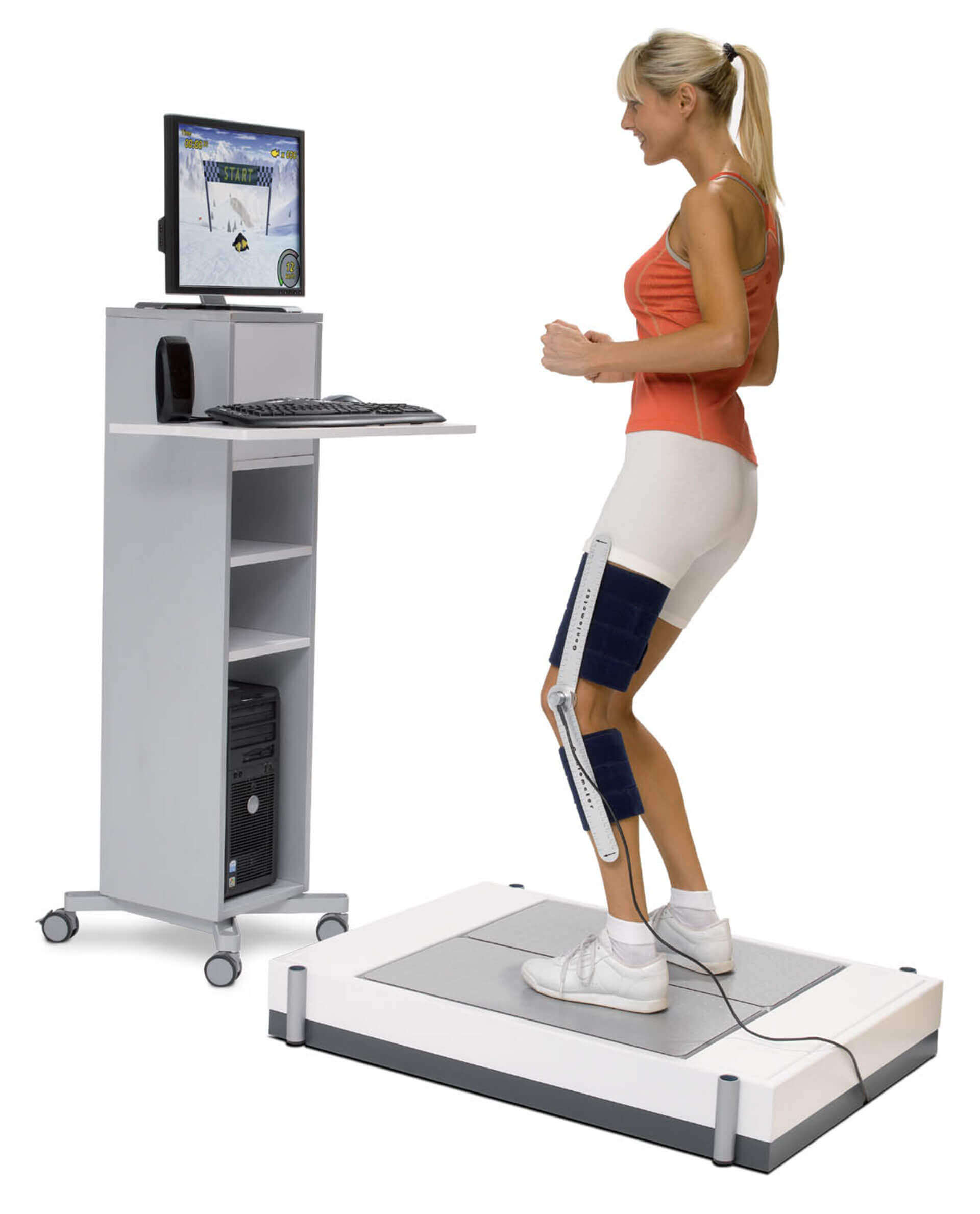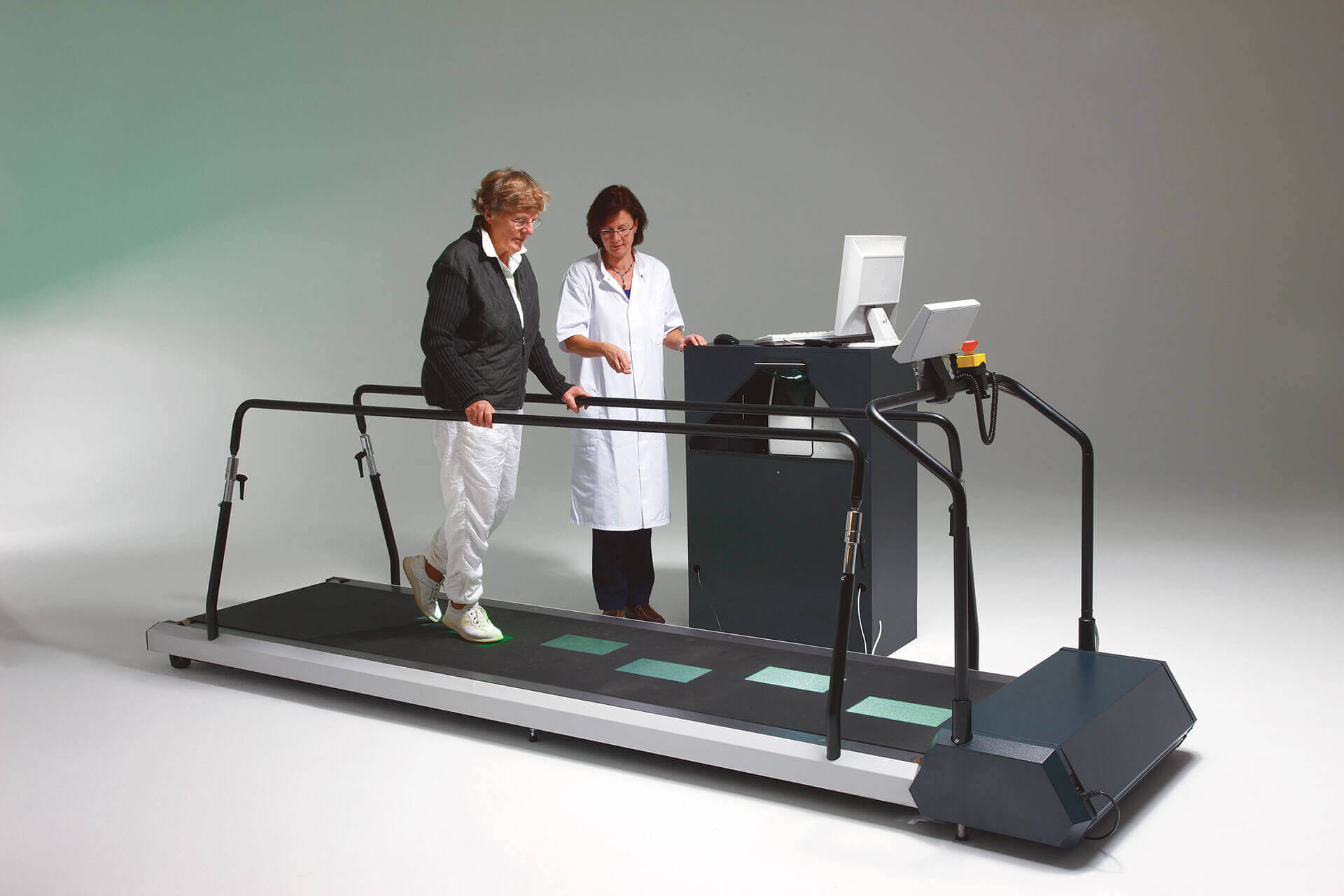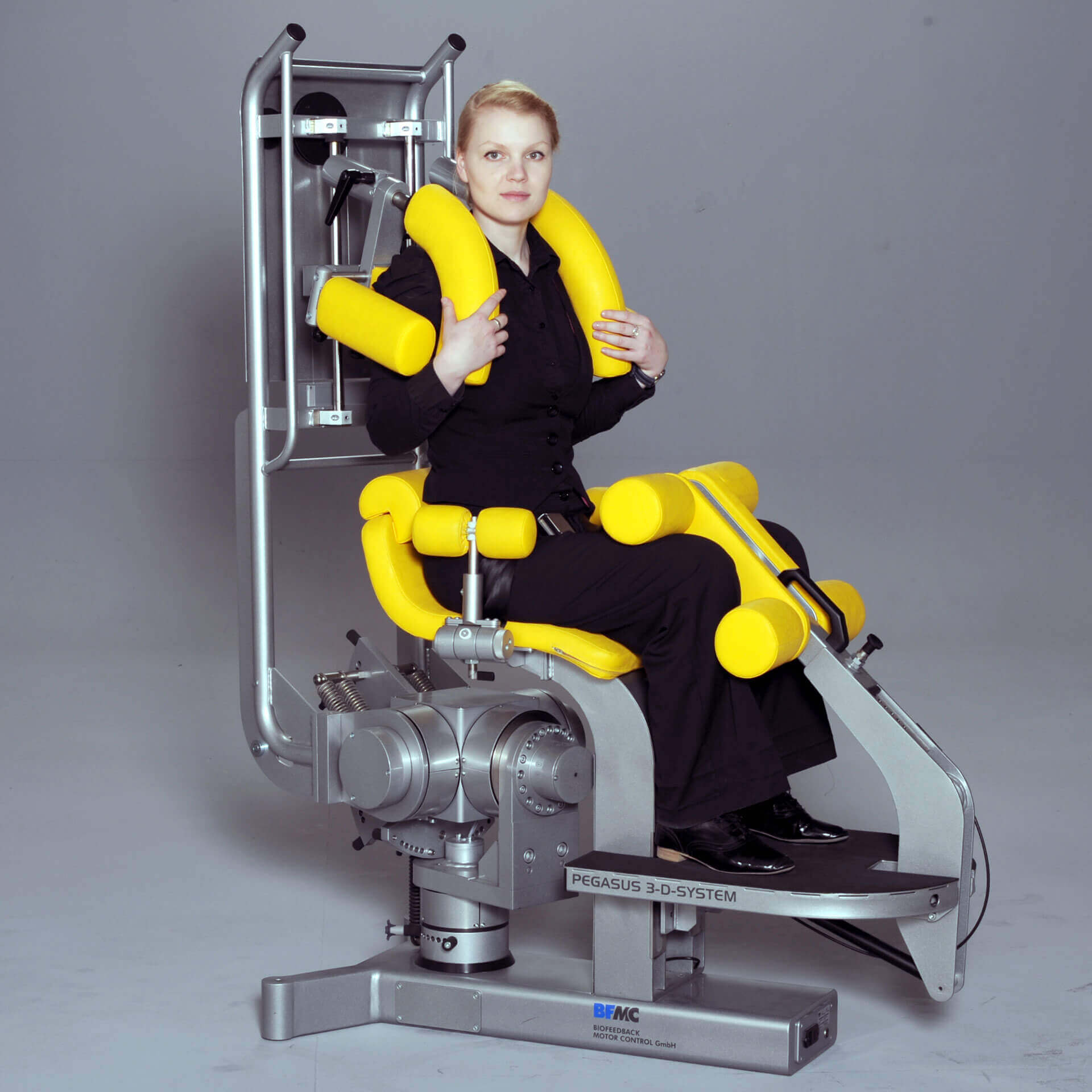COBS
The COBS platform (double) is an innovative, multifunctional, double measuring system. It does not require a predefined positioning of the patient's body, therefore it has a very large area of application. It is also possible to measure and train multiple balance movements.
The load on each leg in Newtons is displayed on the computer screen. Exercises can be performed from various positions. In this way, various motor functions can be measured, such as walking on stairs, jumping or just sitting. As a result, the functional status quo and impairment in lower limb and whole body movements can be measured and recorded. The initial measurements for each patient are recorded as individual protocol and serve as the basis for subsequent training sessions.
Patients with imbalance do not distribute their weight evenly and this becomes visible on the computer screen. Coordination and instability in a joint, such as in trauma, is measured by moving body weight from left to right or from toes to heel. The patient has the ability to observe and control measurements on the monitor. Direct feedback (hint) is a means of motivating patients for a successful session and helps to raise the patient's self-esteem.
The software's versatile capabilities allow you to carry out individual exercises to maintain balance, coordination, reaction, strength and movement planning. All parameters used during training are recorded and can be retrieved for further comparison. This allows you to effectively and objectively assess the success of the exercise in both patients with impairments and athletes.
The COBS ball
Effective prevention of disturbances. Therapy and training of motor functions in rehabilitation and sports medicine. The COBS system with a ball is a multifunctional tool with great feedback capabilities. It can be used alone or in combination with the COBS platform.
A wide range of ball exercises allows you to record and analyze various joint functions such as bending or extending the knee or raising the arm up, for example, lifting a suitcase or pulling up, etc. Direct comparison of different measurements, such as left / right arm strength or data at the beginning of the exercise and subsequent results, gives a comprehensive and objective account of the current state and success of the exercise course. The training process is controlled by a program that provides constant graphic and audio prompts so that the exercises are performed correctly. This double feedback ensures maximum success from your practice. A wide range of exercises will motivate and attract patients for a long time. All data and training results can be printed out as a list, graph or table. With such data, the attending physician can draw conclusions about the success of therapy and this is a key point in the quality control of the exercises performed.
GEO
The key challenge during gait recovery is not only to teach the patient to re-move on a level surface, but also to develop the skills to move up and down stairs, mimicking daily activities. The G-EO robotic system for locomotor therapy is designed to simulate human gait.
EVIDENCE-BASED THERAPY
The operation of the complex is based on the technology of movement of the working organ, thanks to which mechanical orthoses with the highest accuracy imitate the trajectory of movement of the lower extremities, exactly repeating the pattern of a real gait.
UNIQUE OPERATING MODES
Thanks to the innovative design of the system, for the first time, it is possible to simulate walking not only on a flat surface, but also up / down stairs. More varied training leads to better results, according to numerous studies in the field of medical rehabilitation. In addition, such exercises allow you to fully use the strength and range of motion of the lower extremities.
QUICK SETUP
Due to the special design of the system, as well as the folding ramp, preparing the patient for work takes no more than 5-7 minutes and requires the participation of only one specialist.
PEDIATRIC VERSION
Using a special adapter for working with small patients, you do not need to purchase a separate system. The necessary set of accessories allows you to work with children up to 160 cm tall.
ADAPTIVE MODES
Using pressure sensors built into the platforms for the left and right legs, the system constantly analyzes the force developed by the patients themselves during training and, if necessary, increases or decreases the level of robotic intervention. This mode allows you to use the patient's own strengths from the earliest stages, which ultimately leads to more effective rehabilitation.
A specially designed panel is used for the test, which provides a simple and clear input of answers. The use of such a panel increases the motivation of clients and makes the test application suitable for those who for some reason do not fit a standard keyboard, mouse or touch screen.
PARTIAL MOTION TECHNOLOGY
Partial movement training is used in the early stages of rehabilitation to reproduce the sensation of correct movement of the limb and corresponding movement of the center of mass. With this approach, training is not carried out for the full cycle of the step, but only for its selected segments.
AREAS OF USE
Rehabilitation
Neurology
Traumatology
Pediatrics
C-MILL
Daily walking is a complex process involving several body systems. The spinal cord is responsible for the walking reflex, the brain stem - for maintaining balance, the cerebral cortex - for purposeful movement to an object, building a route, working with obstacles on the way. The fundamental difference of the C-mill system is focused work with brain functions damaged by a stroke. As a result, the patient learns to walk, choose the right route and avoid obstacles, and not just walk.
TARGETED NEURO REHABILITATION
A unique multifunctional biofeedback system for biomechanical diagnostics and correction of walking skills in patients after stroke, TBI, and cerebral palsy. The C-Mill treadmill and special software allow you to diagnose gait disturbances, develop an individual algorithm for restoring coordination of movements and conduct effective training. The detailed report contains data on stride length and width, stride symmetry, temporal and spatial characteristics of gait.
PROGRESSIVE REHABILITATION STRATEGY
Thanks to the unique diagnostic capabilities of the C-mill system, the doctor has the opportunity to determine the nature of the gait disorder. Regardless of the degree of damage, the C-mill system will automatically select the pattern of light marking for the patient, which best suits his walking style. By gradually changing this pattern and bringing it to the normative values, the doctor returns the patient to the natural manner of walking. This approach ensures smooth progress and a high level of patient motivation throughout the entire rehabilitation process.
LENGTH OF C-MILL
For a full-fledged functional diagnosis of gait, not imitation, but maximum coincidence with real life conditions is required. The length of the track should allow the patient to accelerate and move forward along the track, slow down and move back without fear of falling, and when working with the projection system, see light markers (targets or obstacles) in advance to understand the next step. Physiologically correct for a person is to look ahead at 3 steps or 2-2.5 m, or, which makes requirements for the length of the track at least 3 meters. The projection on the entire canvas allows you to use the capabilities of the track at 100%, that is, the working area is the entire canvas of the track, and not only the front part (~ 20%).
Projection 2-2.5 m forward is required to create conditions close to real life. On short treadmills, a long look at the feet leads to dizziness, and also makes it impossible to diagnose patients in severe conditions.
C-MILL ADVANTAGES
Versatility
The track can be used by both adults and children, thanks to the availability of special game rehabilitation programs. The position of the handrails is individually adjustable, depending on the patient's height. The maximum patient weight is 135 kg.
Simplicity
During the rehabilitation process, the system itself will select the optimal training parameters for the patient, depending on the degree and nature of the lesion.
Accuracy and objectivity
At the end of each workout, the system will provide a detailed report on the patient's gait status and progress made in the rehabilitation process
ALSO AVAILABLE THE FOLLOWING VERSIONS OF TOUCH TREADMILLS:
1) Walkway with additional safety frame. The presence of movable belay makes classes as safe as possible for the patient.
2) A track with two independent tapes. The setting and regulation of speed occurs independently for each leg, which is important for the rehabilitation of motor skills in patients after stroke, TBI, and cerebral palsy.
FOCUS
When training in water, the weight of the body and all limbs immersed in water is significantly reduced, which affects a significant decrease in weight and allows you to perform a greater range of motion with less muscle strength, less stress on joints, bones and significantly improves the functioning of the vascular system.
The effects of hydrostatic pressure help improve circulation and provide effective treatment for muscles or joints.
Height-adjustable countercurrent of water can be used for additional load and coordination training.
Training in water
More effective vascular training.
Constant hydrostatic pressure.
Joint load can be adjusted using the water level in the chamber, and it takes much less time to achieve the required results.
Lower body training contributes to body balance training. The counter flow provides additional stress and new training approaches.
In rehabilitation treatment, the countercurrent further stimulates muscle development.
CENTAUR
The computerized, diagnostic and rehabilitation system CENTAUR is designed for the development of directly autochthonous muscles of the back using a precisely reproducible load.
It is possible to specifically develop the general musculature of the torso, increase the level of its coordination, as well as deep-lying (autochthonous) muscles.
Detection of neuromuscular imbalances in the lumbar spine and targeted training to correct existing imbalances and deficits.
Thanks to the controlled activation of the autochthonous muscles of the back, targeted training of these muscles became possible for the first time.
Functional training (treatment) to reduce and prevent neuromuscular imbalances and deficits by creating joint tension of the vestibular apparatus and sensorimotor systems of the lumbar, thoracic and cervical regions.
Indications. Vertebral syndromes with the following symptoms: prolapse of the vertebral disc (including postoperative syndrome), protrusion after the acute stage / degenerative changes / cases of spondylosis and displacement of the vertebrae / spinal injury, in relation to conservative or postoperative treatment / recurrent complaints associated with problems of the spinal discs with a significant decrease performance, functional back pain with or without degenerative changes, deficiencies and / or imbalance of the spinal muscles.
The Centaur system works on the basis of the following basic principles of movement:
-With a coordinated tilt of the body, the person's torso tends to stabilize against the forces of gravity
-When tilting and rotating, the body is in an unstable position, so that the balance analyzer sends impulses to the deep muscles
-With a vertical-inclined arrangement during training, muscles are strengthened in a position in which they must do maximum work to support the body
A precisely reproducible load makes it possible to carry out targeted and reliably documented therapy or training
Connecting the simulator to a computer network and storing data for effective testing and training
PEGASUS
Pegasus is a modern, universal system designed for complex diagnostics and rehabilitation of the spine. The system allows accurate and objective measurements in all three axes, aimed at assessing flexibility and muscle strength, and then, based on the data obtained during the measurements, assign the required training program. The training takes place in a biofeedback mode, which significantly increases the patient's level of motivation and leads to an overall increase in the effectiveness of the rehabilitation course
FEATURES OF PEGASUS
The ability to accurately dose structured loads through training with biofeedback
Collection of individual information
Determining the Exercise Required
Training control through feedback
Detailed display of results and training report
PEGASUS CONCEPT
The PEGASUS concept is based on the fact that most diseases of the back and spine are somehow associated with neuromuscular deficits or imbalances. Neuromuscular imbalance is an asymmetry in the development of the muscles. Neuromuscular deficiency is a weakened musculature. They can develop due to various reasons: trauma, lack of exercise, morphological features or characteristics of the patient's daily activities. For successful therapy, it is important to recognize and eliminate deficiencies / imbalances in time:
Neuromuscular imbalances are determined by measuring strength and range of motion in major anatomical planes and comparing the results
Neuromuscular deficits are determined by measuring the strength and range of motion in the main anatomical planes and comparing the results with the standard values
Neuromuscular imbalances and deficits are reduced by creating a certain tension in the ODA through a dosed load.
THREE-DIMENSIONAL TESTING AND TRAINING
With the help of the PEGASUS system, diagnostics and training becomes possible in all three dimensions:
Measurement of the range of motion of the spine to objectify the existing DF, determine the goal of treatment and document the rehabilitation process.
Measurement of tension at any point in the anatomical planes of the motor function of the thoracic and lumbar regions.
Conducting special training (treatment) of the sensorimotor systems of the thoracic and lumbar regions in isometric and isotonic modes.
DOSED LOAD
Only precisely dosed physical activity has a therapeutic effect. It is PEGASUS that allows you to create the desired load individually for each patient and, if necessary, accurately reproduce it in subsequent sessions.
Measurements at any arbitrary measurement point in the spatial range of motion of the lumbar spine:
Isometric Peak Force Diagnostics
Developing flexibility and coordination for auxotonic workloads
Development of strength differentiation and strength coordination during isometric workloads
The development of maximum strength and strength endurance of the muscles of the lumbar spine during isometric workloads.






